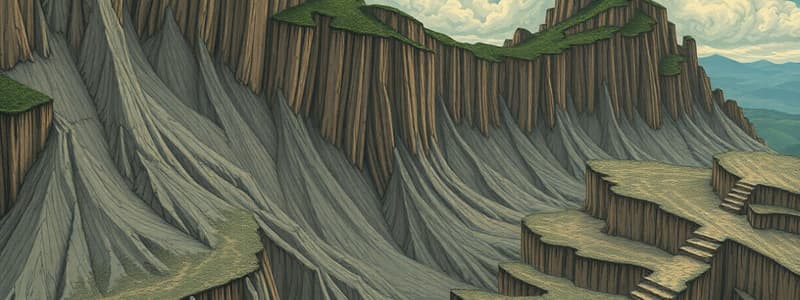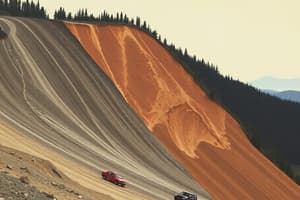Podcast
Questions and Answers
MASS WASTING is also known as ______.
MASS WASTING is also known as ______.
SLOPE FAILURE
Unconsolidated materials include clay, silt, sand, and ______.
Unconsolidated materials include clay, silt, sand, and ______.
gravel
EROSION is the geological process in which materials are worn away and transported by ______ or water.
EROSION is the geological process in which materials are worn away and transported by ______ or water.
wind
A SLOPED surface’s stability depends on the angle of the slope and the strength of the underlying ______.
A SLOPED surface’s stability depends on the angle of the slope and the strength of the underlying ______.
Signup and view all the answers
SHEAR STRENGTH refers to the strength of interaction between a chunk of rock and the ______ surface.
SHEAR STRENGTH refers to the strength of interaction between a chunk of rock and the ______ surface.
Signup and view all the answers
The FORCE acting downwards towards Earth’s center is known as ______.
The FORCE acting downwards towards Earth’s center is known as ______.
Signup and view all the answers
SHEAR FORCE is a component of gravitational force that acts ______ to the slope.
SHEAR FORCE is a component of gravitational force that acts ______ to the slope.
Signup and view all the answers
As the slope gets steeper, the greater the ______ force.
As the slope gets steeper, the greater the ______ force.
Signup and view all the answers
Shear force is a force component that acts ______ to the slope.
Shear force is a force component that acts ______ to the slope.
Signup and view all the answers
As the slope increases, shear force ______ as well.
As the slope increases, shear force ______ as well.
Signup and view all the answers
Chunk of rock will likely move if shear force is ______ than shear strength.
Chunk of rock will likely move if shear force is ______ than shear strength.
Signup and view all the answers
Younger mountains tend to be ______ as they have not eroded as much as older mountains.
Younger mountains tend to be ______ as they have not eroded as much as older mountains.
Signup and view all the answers
If shear force is less than shear strength, the chunk of rock does ______ move.
If shear force is less than shear strength, the chunk of rock does ______ move.
Signup and view all the answers
Older mountains are less steep due to hundreds of millions of years of ___.
Older mountains are less steep due to hundreds of millions of years of ___.
Signup and view all the answers
Shear strength is the strength of interaction between rock and ______.
Shear strength is the strength of interaction between rock and ______.
Signup and view all the answers
The strength of the interaction between rock and surface is referred to as ___.
The strength of the interaction between rock and surface is referred to as ___.
Signup and view all the answers
Rocks that form from molten material cooling are classified as ___.
Rocks that form from molten material cooling are classified as ___.
Signup and view all the answers
___ rocks are formed from sediments and can contain pieces of once-living organisms.
___ rocks are formed from sediments and can contain pieces of once-living organisms.
Signup and view all the answers
Rocks that have been transformed by high pressure and high heat are called ___.
Rocks that have been transformed by high pressure and high heat are called ___.
Signup and view all the answers
As rock strength increases, ___ also increases.
As rock strength increases, ___ also increases.
Signup and view all the answers
Sedimentary rocks are characterized by having ___.
Sedimentary rocks are characterized by having ___.
Signup and view all the answers
Transformation of rocks through high pressure and heat is known as ___.
Transformation of rocks through high pressure and heat is known as ___.
Signup and view all the answers
Rocks made of crystallized molten materials are known as ______.
Rocks made of crystallized molten materials are known as ______.
Signup and view all the answers
An example of an igneous rock is ______.
An example of an igneous rock is ______.
Signup and view all the answers
As rock strength increases, so does ______ strength.
As rock strength increases, so does ______ strength.
Signup and view all the answers
A weak sedimentary rock made of very fine particles is called ______.
A weak sedimentary rock made of very fine particles is called ______.
Signup and view all the answers
The sedimentary rock that consists of gravel-sized chunks cemented together is known as ______.
The sedimentary rock that consists of gravel-sized chunks cemented together is known as ______.
Signup and view all the answers
______ is primarily made up of the mineral calcite.
______ is primarily made up of the mineral calcite.
Signup and view all the answers
Sedimentary rocks can show a large range of strengths, including strong varieties like ______.
Sedimentary rocks can show a large range of strengths, including strong varieties like ______.
Signup and view all the answers
Sandstone is made up of sand grains held together by ______.
Sandstone is made up of sand grains held together by ______.
Signup and view all the answers
Study Notes
Mass Wasting/Landslides
- Mass wasting is the downslope movement of rock or unconsolidated materials due to gravity.
- Unconsolidated materials are derived from the disintegration and erosion of rocks, including clay, silt, sand, and gravel.
- Landslides are a specific type of mass wasting, characterized by a rapid slope failure.
- Erosion is the geological process in which materials are worn away by wind or water. Erosion and the breakdown of hills and mountains is primarily driven by gravity.
- Sloped surfaces vary in stability, depending on the angle of the slope and the strength of the underlying material.
Mass Wasting: An Introduction
- A chunk of rock on a sloped surface will move down the surface if the shear force between the rock and the surface is greater than the shear strength.
- Gravity pulls everything towards Earth's center. A portion of the gravitational force acts to pull the rock down the slope.
- Shear force is a component of gravity, parallel to the slope. The component perpendicular to the slope is called normal force. The shear force can cause the rock to move downhill. A steeper slope results in greater shear force.
- Shear strength is the strength of the interaction between the rock and the surface.
- If shear force is less than the shear strength, the rock will not move.
Mass Wasting: Shear Force
- Shear force, shear strength, and the angle of the slope all play a key role in determining if a mass will move down slope
- Different cases (a, b, and c) were presented in the slides discussing shear force versus shear strength.
- Case (a) shows that shear force is less than shear strength resulting rock not moving. Case (b) shows shear force is nearly the same as the strength, but there is still a chance that the rock may or may not move. Case (c), shows that shear force is greater than shear strength resulting in likely movement of the rock mass.
- Younger mountains have steeper slopes compared to older mountains due to less time being subjected to erosion by wind or water.
Mass Wasting: Rock Strength
- Shear strength increases as rock strength increases.
- Rocks composed of crystallized materials like granite and basalt possess high strength.
- Sedimentary rocks (like dolostone, limestone, sandstone, and mudstone) demonstrate variations in strength.
- Some sedimentary rocks (like dolostone and limestone) are relatively strong due to strong mineral bonds between minerals.
- Others (like mudstone) are soft and brittle because they are composed of very fine particles.
- The strength of the cementing material and the overall composition of the rock affect how strong the rock is.
Classification of Rocks
- Rocks are classified into igneous, sedimentary, and metamorphic rocks.
- Igneous rocks form from cooled molten material, often featuring visible crystals. They are never layered.
- Sedimentary rocks form from sediments, often showing layering and a gritty texture. They are commonly made from pieces of rocks and organisms.
- Metamorphic rocks are igneous or sedimentary rocks that have been transformed by high heat and pressure. Also commonly found deep in the Earth.
Studying That Suits You
Use AI to generate personalized quizzes and flashcards to suit your learning preferences.
Related Documents
Description
Explore the fundamentals of mass wasting and landslides in this quiz. Understand the processes, causes, and factors affecting slope stability and erosion. Ideal for students studying geology and environmental sciences.




